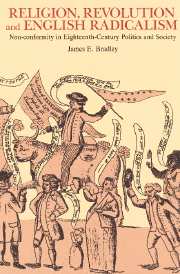 Religion, Revolution and English Radicalism
Religion, Revolution and English Radicalism Published online by Cambridge University Press: 29 October 2009
The Dissenters experienced serious numerical decline after 1715 and this fact has contributed to the judgment that they were politically insignificant. C. E. Fryer made the first modern attempt to quantify the decline. In response to Richard Lodge's observation that since 1688 the Dissenters were the ‘backbone of the Whig party’, Fryer concluded that ‘neither upon the ground of numbers nor of political influence can the Dissenters be assigned any such anatomical importance’. This viewpoint has passed over into the body of common knowledge, so that one influential study of the Dissenters can say, ‘they were also thought to be fast declining and thus politically unimportant’. The anachronistic assumption behind such a statement is that numbers in eighteenth-century English politics counted for more than influence and patronage. In the decade of the 1770s, however, at the nadir of their numerical strength, the Dissenters exerted more political influence than they had fifty years before when they were far stronger numerically. Moreover, Fryer's statement ignores the critical issue of geography; a decline in numbers would have no bearing whatever on those boroughs where the franchise was tied to specific plots of land, and in several sections of England, Dissenters declined in the counties, but maintained their numbers in the large freeman boroughs. The failure of past treatments to keep numbers related to influence, and the concentration of population related to parliamentary boroughs, has seriously obscured the Dissenters' role in politics.
To save this book to your Kindle, first ensure no-reply@cambridge.org is added to your Approved Personal Document E-mail List under your Personal Document Settings on the Manage Your Content and Devices page of your Amazon account. Then enter the ‘name’ part of your Kindle email address below. Find out more about saving to your Kindle.
Note you can select to save to either the @free.kindle.com or @kindle.com variations. ‘@free.kindle.com’ emails are free but can only be saved to your device when it is connected to wi-fi. ‘@kindle.com’ emails can be delivered even when you are not connected to wi-fi, but note that service fees apply.
Find out more about the Kindle Personal Document Service.
To save content items to your account, please confirm that you agree to abide by our usage policies. If this is the first time you use this feature, you will be asked to authorise Cambridge Core to connect with your account. Find out more about saving content to Dropbox.
To save content items to your account, please confirm that you agree to abide by our usage policies. If this is the first time you use this feature, you will be asked to authorise Cambridge Core to connect with your account. Find out more about saving content to Google Drive.